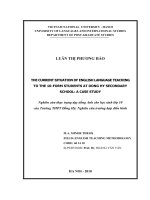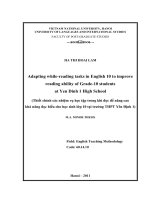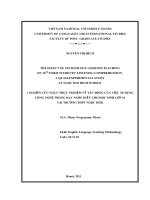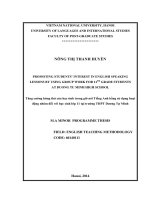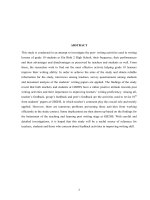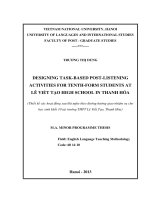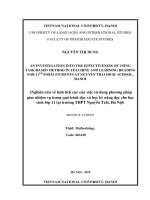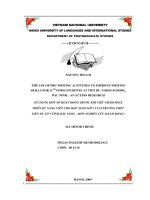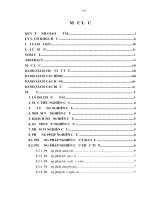Sử dụng các hoạt động đóng kịch để nâng cao động lực học tập và khả năng nói tiếng Anh cho học sinh lớp 10 tại Trường THPT Nam Cao
Bạn đang xem bản rút gọn của tài liệu. Xem và tải ngay bản đầy đủ của tài liệu tại đây (1.15 MB, 58 trang )
VIETNAM NATIONAL UNIVERSITY, HANOI
UNIVERSITY OF LANGUAGES AND INTERNATIONAL STUDIES
FACULTY OF POST-GRADUATE STUDIES
****************
TRẦN THỊ PHẤN
THE USE OF ROLE PLAY ACTIVITIES IN
ENHANCING 10
TH
GRADERS’ MOTIVATION AND
SPEAKING PERFORMANCE AT NAM CAO HIGH
SCHOOL
(Sử dụng các hoạt động đóng kịch để nâng cao động lực học
tập và khả năng nói tiếng Anh cho học sinh lớp 10 tại
Trường THPT Nam Cao)
M.A. MINOR THESIS
Field: English Teaching Methodology
Code: 60.14.10
Hanoi, 2013
VIETNAM NATIONAL UNIVERSITY, HANOI
UNIVERSITY OF LANGUAGES AND INTERNATIONAL STUDIES
FACULTY OF POST-GRADUATE STUDIES
****************
TRẦN THỊ PHẤN
THE USE OF ROLE PLAY ACTIVITIES IN
ENHANCING 10
TH
GRADERS’ MOTIVATION AND
SPEAKING PERFORMANCE AT NAM CAO HIGH
SCHOOL
(Sử dụng các hoạt động đóng kịch để nâng cao động lực học
tập và khả năng nói tiếng Anh cho học sinh lớp 10 tại
Trường THPT Nam Cao)
M.A. MINOR THESIS
Field: English Teaching Methodology
Code: 60.14.10
Supervisor: Dr. Đỗ Tuấn Minh
Hanoi, 2013
i
CANDIDATE’S STATEMENT
I certify my authority of the Study Project Report entitled “THE USE OF ROLE
PLAY ACTIVITIES IN ENHANCING 10
TH
GRADERS’ MOTIVATION
AND SPEAKING PERFORMANCE. A CASE STUDY AT NAM CAO HIGH
SCHOOL” in partial fulfillment of the requirements for the Degree of Master of
Arts.
Tran Thi Phan
Hanoi, 2013
ii
ACKNOWLEDGEMENTS
This research thesis would not have been completed without the support of my
supervisor, my lecturers, my colleagues, my students and my family members.
First of all, I would like to express my deepest thanks to my supervisor, Dr Do Tuan
Minh whose expert guidance, vast knowledge of educational research and teaching
experience greatly supported me during the time I carried out the thesis.
I would like to take this opportunity to express my gratitude to all my lecturers at
the Department of Post-graduate Studies, University of Languages and International
Studies, Vietnam National University, Hanoi. Their sincere support and
considerations have enabled me to pursue and finish the course.
I would also like to thank all the teachers at Nam Cao high school who kindly
helped me to answer the survey questionnaire and give practical solutions.
Appreciation is also extended to 90 10
th
grade students at Nam Cao high school for
their patience and prompt responses to the questionnaires.
Last but not least, I would like to thank, with all my heart, my family for
encouraging me to finish this thesis.
iii
ABSTRACT
In recent years, mastering students’ oral communication is one of the ultimate
goals of foreign language teaching. However, in the reality, the teachers and
students from Nam Cao high school have problems in teaching and learning English
speaking. This research was carried out to examine how the speaking skill of 10
th
graders at Nam Cao high school can be improved through using role play activities,
and investigating the students’ attitudes toward using role play activities in teaching
and learning English and the use of role play by teachers in teaching speaking skill
as well. The findings of study showed that role play activities are an effective
teaching technique which should be widely exploited in teaching and learning
English speaking to enhance 10
th
graders’ motivation and speaking performance. In
short, it is hoped that this thesis will help to improve the teaching and studying of
speaking skill at Nam Cao high school.
iv
TABLE OF CONTENTS
Page
Certificate of originality of study project report i
Acknowledgements ii
Abstract iii
Table of contents iv
List of abbreviations vi
Table of figures vii
PART I: INTRODUCTION
1. Rationale 1
2. Aims and research questions 2
3. Significance of the study 2
4. Scope of the study 3
5. Methods of the study 4
6. Thesis organization 4
PART II: DEVELOPMENT 5
CHAPTER 1 : LITERATURE REVIEW 5
1.1. Overview of motivation in language teaching 5
1.1.1. Definition of motivation 5
1.1.2. The importance of motivation in language learning 5
1.2. Speaking skill 6
1.2.1. Definition of speaking skill 6
1.2.2. Teaching speaking skill in Communicative Language teaching 7
1.2.3. Principles of teaching speaking 8
1.2.4. The components of speaking skill 8
1.2.5. A succesful speaking lesson in classroom 9
1.2.6. Activities to promote speaking 10
1.3. Overview of role play 11
1.3.1. Definition of role play 11
1.3.2. Types of role play 12
1.3.3. Stages of a standard role play 14
1.3.4. Significance of role play in teaching speaking 15
v
CHAPTER 2: METHODOLOGY………………………………………………….… 17
2.1. Research hypothesis 17
2.2. Setting of the study 17
2.3. Participants of the study 17
2.4. General description of the curriculum of textbook Tiếng Anh 10 18
2.4.1. Overall design 18
2.4.2. The curriculum and textbook Tiếng Anh 10 18
2.4.3. Sections for speaking skills in the textbook Tiếng Anh 10 19
2.5. Research instruments 20
2.6. Procedures of data collecion 21
2.7. Procedures of data anlaysis 22
CHAPTER 3: DATA ANALYSIS AND DISCUSSION……………………………….23
3.1. Data analysis and discussion from Phase 1………………………………………… 23
3.1.1. Data analysis from Phase 1…………………………………………………………23
3.1.2. Discussion from Phase 1……………………………………………………………27
3.2. Data analysis and discussion from Phase 2………………………………………… 28
3.2.1. Data analysis from students’ survey questionnaires……………………………… 28
3.2.2. Data analysis from teachers’ questionnaires……………………………………… 30
3.2.3. Data analysis from classroom observation……………………………………… 34
3.2.4. Discussion from Phase 2……………………………… ………………………….33
PART III: CONCLUSION 36
1. Major findings of the study 36
2. Pedagogical implications 37
3. Limitations and suggestions for further studies……………………………………… 39
REFERENCES 40
APPENDICES I
vi
LIST OF ABBREVIATIONS
CLT Communicative Language Teaching
T Teacher
Ss Students
N Number
% Percent
vii
TABLE OF FIGURES
TABLES
Table 1: Teachers’ and students’ opinions towards the importance of teaching and
learning speaking skill
Table 2: Students’ interest in learning speaking skill
Table 3: Teachers’ and students’ evaluation towards speaking activities in the
textbook English 10
Table 4: Students’ knowledge towards the term “role play”
Table 5: Frequency of role play activities in speaking lessons
Table 6: Results from students’ survey questionnaires
Table 7: Teachers’ opinions towards the importance of role play activities in
speaking lessons
Table 8: Ways of motivating students to take part in role play activities
Table 9: Teachers’ preparation for role play activities
Table 10: Best time for teachers to implement role play activities in speaking
lessons
Table 11: Ways of organizing the class for role play activities in speaking lessons
Table 12: Kinds of correction techniques used in giving feedback on students’ doing
role-play activities
Table 13: Teachers’ evaluation of students’ improvement in speaking ability after
using role play activities
Table 14: Teachers’ expectation towards integrating role play activities in speaking
lessons
CHARTS
Chart 1: Language used by students in speaking lesson
Chart 2: Teachers’ and students’ self-evaluation towards students’ speaking ability
viii
1
PART A: INTRODUCTION
1. Rationale of the study
Nowadays, English has become one of the most important languages in the
world. Especially in the globalization trend, it is spoken as a second language and
an official language in many countries, and as a foreign language in the global
world as well. Almost all the people from many different countries around the
world use it to communicate. At high schools in the whole country, English is now
a compulsory subject for all students. In traditional teaching, students were required
to acquire English grammar; however, nowadays in the light of Communicative
Language Teaching (CLT), they are required to acquire various skills and language
items. In the international relationship, English speaking ability is very important
for people to be able to integrate into the wide world. The speaking skill is
measured in terms of the ability to carry out a conversation in the language.
Therefore, in some recent years, the focus of teaching has been promoting oral skills
in order to respond to the students’ needs for effective communication and the
ability to communicate in it efficiently has been the goal of every learner. However,
how to teach and learn speaking effectively is still a challenging question to both
teachers and students at many high schools in Vietnam. Evidence shows that too
many school students are unwilling to take part in speaking activities in class
despite teachers’ efforts to provide students with opportunities to develop their
communicative skills. This may be caused by a variety of factors coming from
teachers’ side, students’ side and others including classroom environment,
types and contents of activities, etc. Among those factors, students’ lack of
motivation has been considered as the important one. Motivation is one of the key
issues in language teaching and it has long been believed to have a good impact on
success or failure of a language learner. Skills and techniques to motivate students
to practice the four basic skills, especially speaking skill, are essential for language
teachers. Thus, to motivate students in a speaking lesson, teachers often use a wide
variety of communicative activities such as discussion, role-play, simulations,
2
information gap, jigsaw, etc. Among them, role play is regarded as a very typical
and effective way to improve students’ speaking performance. According to
Ladousse (1987), a role play uses different communicative techniques and
develops fluency in the language, promotes interaction in the classroom and
increases motivation. Role play can improve students' speaking skills in any
situation, and helps them to interact. As for the shy students, role play helps
provide a mask, where students with difficulty in conversation are open minded.
Besides, Jeremy Harmer (1986) advocates the use of role-play for the following
reasons:
- It's fun and motivating
- Quieter students get the chance to express themselves in a more forthright
way.
- The world of the classroom is broadened to include the outside world,
thus offering a much wider range of language opportunities
- Real situations can be created and students can benefit from the practice
- Mistakes can be made with no drastic consequences
From my point of view, it is of great importance to investigate the effectiveness
of role-play activities in enhancing students’ motivation and speaking performance.
That is the reason why I would really like to conduct a study on “The use of role
play activities in enhancing 10
th
graders’ motivation and speaking performance.
A case study at Nam Cao high school”. It is hoped that the research will be a
certain contribution to the improvement of teaching speaking skill for students at
Nam Cao high school.
2. Aims and research questions
The study is conducted with the aim of investigating the use of role play
activities in speaking lessons at Nam Cao high school. In details, the aims of the
study are:
- Explore the attitudes of students at Nam Cao high school towards applying
role-play to speaking lessons.
3
- Investigate the use of role-play activities by teachers at Nam Cao high school
in teaching speaking to 10
th
graders.
- Investigate the effectiveness of role- play activities in enhancing motivation
and speaking performance of 10
th
grade students at Nam Cao high school.
The present study is designed to answer the following questions:
1. What are the attitudes of students at Nam Cao high school towards using role-
play activities in a speaking lesson?
2. How do teachers of English at Nam Cao high school teach speaking to 10
th
grade students with role play activities?
3. In what ways do role-play activities improve motivation and speaking
performance of 10
th
grade students at Nam Cao high school?
3. Significance of the study
The research is a great attempt to investigate the effectiveness of role-play
activities in motivating 10
th
grade students at Nam Cao high school to participate in
English speaking lessons. Once completed, it will be a useful source for those who
are English teachers at high schools. Moreover, this study provides teachers at Nam
Cao high school suggestions to apply role-play activities successfully. Thus, the
results of the research will make a great contribution to the improvement of
teaching speaking skill for students at high schools.
4. Scope of the study
Although there are many different ways to motivate students in English
speaking lesson, all these issues cannot be fully covered in this paper. Due to the
limited time and the length of the study, the researcher only focuses on exploiting
role-play activities as a way of motivating 10
th
grade students at Nam Cao high
school in English speaking lessons. Besides, the target that the study investigates
and serves is just 90 students from 2 classes of grade 10 in the context of Nam Cao
high school.
4
5. Method of the study
With the aim of addressing the research questions, techniques of an action research
are used: survey questionnaires and classroom observation. Both quantitative and
qualitative methods are employed to carry out the study.
6. Thesis organization
This study consists of three main parts:
Part I, Introduction presents the rationale of the study, the aims of the study,
research questions, scope of the study, significance of the study, methods of the
study, and organization of the study.
Part II, Development includes three following chapters.
Chapter 1, Literature Review displays the theoretical background of motivation,
teaching speaking skills and role play.
Chapter 2, Methodology presents the context of the study, participants, research
instruments and data collection procedures
Chapter 3, Data Analysis and Discussion, provides an analysis of the data as well as
the interpretation of the results
Part III, Conclusion summarizes the findings, and pedagogical implications,
limitations of the study and suggestions for further study are provided in this part.
References and Appendices are presented in the last pages of the study.
5
PART II: DEVELOPMENT
Chapter 1: LITERATURE REVIEW
This chapter will explore some theoretical background to the study. It firstly
discusses the concept of motivation and later discusses the concept of speaking skill.
In addition, the chapter will also review the concept of role play in the context of
teaching and learning speaking skill.
1.1. Overview of motivation in language learning
1.1.1. Definition of motivation
There have been a great number of different theories of motivation
throughout many researches in years. Burden (1997:119) assumed that “from a
cognitive perspective, motivation is concerned with such issues as why people
decide to act in certain ways and what factors influence the choice they make. It
also involves decisions as to the amount of effect people are prepared to expand in
attempting to achieve their goals. The role of the teacher thus becomes one of
helping and enabling learners to make suitable decisions”. Dornyei (2001:17) stated
that “motivation explains why people decide to do something, how hard they are
going to pursue it and how long they are willing to sustain the activities”
Additionally, Woolfolk (2001:366) defines motivation as “an internal state that
arouses, directs and maintains behavior”. Briefly, motivation is something involving
the attitudes and affective states that influence the degree of effort that one makes to
achieve some certain goal.
1.1.2. The importance of motivation in language learning
Motivation has become more commonly recognized as the major factor on
success or failure of a language learner. As William T. Littlewood puts it (1984:53),
“in second language learning as well as in every other field of human learning,
motivation is the crucial force which determines whether a learner embarks on a
task at all, how much energy he devotes to it, and how long he perseveres”. Besides,
6
Oxford and Shearin (1996:121-122) also argue: “Motivation is important because it
directly influences how often students use L2 learning strategies, how much
students interact with native speakers, how much input they receive in the language
being learned (the target language), how well they do on curriculum-related
achievement tests, how high their general proficiency level becomes, and how long
they persevere and maintain L2 skills after language study is over. Therefore,
motivation is crucial for L2 learning, and it is essential to understand what our
students’ motivations are”. As a result, motivation should be paid much attention in
teaching and learning second languages.
1.2. Speaking skill
1.2.1. Definition of speaking skill
The term “speaking” has been defined in different ways by different authors;
however, they all state that speaking involves in speech. It is common knowledge
that speech plays an important role in our lives and a fundamental key to human
communication.
In Oxford Advanced Dictionary the definition of speaking is “to express
or communicate opinions, feelings, ideas, etc, by or as talking”. According to
Chaney (1998: 13), speaking is “the process of building and sharing meaning
through the use of verbal and non-verbal symbols, in a variety of contexts”.
Also, Florez (1999: 1) takes the view that speaking is “an interactive process of
constructing meaning that involves producing and receiving and processing
information”. Its form and meaning are dependent on the context in which it occurs.
It is “often spontaneous, open-ended, and evolving” (ibid.:1), but it is not
completely unpredictable.
In language teaching, speaking is regarded as one of the four important language
skills. According to O’Malley and Pierce (1996), speaking seems to be an important
skill that a learner should acquire. It is very important in order to enable students to
communicate effectively through oral language because the disability of the
7
students to speak may lead them to be unable to express their ideas even in a simple
form of conversation. Also regarding speaking as a skill, Nunan (2003:48) states
that “speaking is the productive oral skill. It consists of producing systematic verbal
utterance to convey meaning”. In other words, Hornby (1995:37) stresses that
speaking is the skill that the students will be judged upon most in real-life
situations. It is an important part of everyday interaction and most often the first
impression of a person is based on his/her ability to speak fluently and
comprehensively. So, teachers have a responsibility to prepare the students as much
as possible to be able to speak in English in the real world outside the classroom.
Indeed, speaking requires that learners not only know how to produce specific
points of language such as grammar, pronunciation, or vocabulary (“linguistic
competence”), but also that they understand when, why, and in what ways to
produce language (“sociolinguistic competence”). Since speaking skill is so
important in enhancing the students’ communicative competence, speaking should
be considered as “a skill which deserves attention as much as the literary skills in
both native and foreign languages" (Bygate, 1987:2)
1.2.2. Teaching speaking skill in Communicative Language Teaching (CLT)
Speaking is a crucial part of second language learning and teaching.
Despite its importance, for many years, teaching speaking has been
undervalued and English language teachers have continued to teach speaking just
as a repetition of drills or memorization of dialogues. However, today's world
requires that the goal of teaching speaking in CLT is communicative competence
because, only in that way, students can express themselves and learn how to
follow the social and cultural rules appropriate in each communicative
circumstance. Therefore, what is meant by teaching speaking is to teach learners to:
1. Produce the English speech sounds and sound patterns
2. Use word and sentence stress, intonation patterns and the rhythm of the
second language.
8
3. Select appropriate words and sentences according to the proper social setting,
audience, situation, and subject matter.
4. Organize their thoughts in a meaningful and logical sequence.
5. Use language as a means of expressing values and judgments.
6. Use the language quickly and confidently with few unnatural pauses, which
is called as fluency. (Nunan, 2003)
1.2.3. Principles for Teaching Speaking
According to H. Douglas Brown (1994), there are seven principles for teaching
speaking:
Focus on both fluency and accuracy, depending on your objectives
Provide intrinsically motivating techniques
Encourage the use of authentic language in meaningful contexts
Provide appropriate feedback and correction
Capitalize on the natural link between speaking and listening
Give students opportunities to initiate oral communication
Encourage the development of speaking strategies.
1.2.4. The Components of Speaking Skill
Both Nurgiyantoro (1987:259-260) and Syakur (1987: 3) share the same idea
that components of speaking are pronunciation, grammar, vocabulary, fluency, and
comprehension.
• Comprehension: For oral communication certainly requires a subject to respond
to speech as well as to initiate it.
• Grammar: It concerns with how to arrange a correct sentence in conversation.
•Vocabulary: Vocabulary means the appropriate diction which is used in
conversation.
• Pronunciation: Pronunciation is the students’ way to utter English well and it
deals with phonology.
• Fluency: It can be defined as the ability to speak fluently and accurately suited
with professional necessity.
9
1.2.5. A successful speaking lesson in classroom
Ur (1996:120) proposes four elements of a successful speaking lesson as
follows:
Learners talk a lot
A speaking class indicated by most of the period time allotted the activity is in fact
occupied by learner talk. It seems obvious, but most time is taken up with teacher
talk or pause.
Participation is even
A monitoring of talkative participant doesn’t dominate classroom discussion here, it
is hinted that all get a chance to speak and are fairly evenly distributed.
Motivating is high
This is indicated by the eagerness of the learners to speak. Students are interested in
the topic and have something new to say about it.
Language is of an acceptable level
It means that learns need to express themselves in utterances that are relevant, easy
to comprehend each other and can be acceptable level language accuracy.
According to Nunan (1996: 32) successful oral communication should involve
developing:
The ability to articulate phonological features of the language
comprehensibly;
Mastery of stress, rhythm, intonation patterns; an acceptable degree of
fluency;
Transactional and interactional skills;
Skills in talking short and long speaking in turns, in the management of the
interaction, and in negotiating meaning;
Conversational listening skills (successful conversations require good
listeners as well as speakers);
Skills in knowing about and negotiating purposes for conversations;
Using appropriate conversational formulate and fillers.
10
Also, Harmer (2001) states that in a successful communicative task the
learners should have a desire to talk, they should have a purpose for
communicating, they should focus on content not on form and they should also use
a variety of language.
It is undeniable that in the context of language teaching and learning,
implementing such a speaking activity that satisfies all above mentioned criteria is
not an easy task, but it is necessary to remind language teachers of them as they
design and administer such activities.
1.2.6. Activities to promote speaking
Structured Output Activities
Two common types of structured output activities are information gap and
jigsaw activities. In these types of activities, students are required to complete a task
by obtaining missing information. Information gap and jigsaw activities also set up
practice on specific items of language. Students can practice a set of structures and
language repeatedly but in a meaningful way.
Communicative Output Activities
Communicative output activities allow students to practice using all of the
language they know in situations that resemble real on texts. In these activities,
students must work together to develop a plan, resolve a problem, or complete a
task. The most common types of communicative output activity are role plays and
discussions.
In brief, whatever the activity that the teacher uses, it must concern with the
development of students interaction and the increasing of their speaking ability. In
further, this intends to discuss classroom activities that aim at encouraging
communication or interaction between students to talk to each other in pairs or in
groups.
11
1.3. Overview of role play
1.3.1. Definition of role play
According to Killen (2008), role play is “a technique which provides an
opportunity for students to become more deeply involved in thinking about how
they would react in real world situation”. In Longman Dictionary of Contemporary
English, role play is defined as “an activity in which you pretend to be in a
particular situation, especially to help you learn a language or deal with problems”.
In defining role play, Donn Byrne (1976) gave comments that “role play is a part of
drama activity”. In details, he described that there are three terms to cover the
drama activities. They are mime (mimicry-memorization), role play and simulation.
The terms were distinguished as follows:
a. Mime, the participants perform actions without using words (although as we shall
see, this activity leads naturally on to talk).
b. Role play, the participant interact either as themselves in imaginary
situations.
c. Simulation, this involves role play as defined above. However, for this
activity the participants normally discuss a problem of some kind with some
setting that has been defined for them.
From his point of view, both role play and simulation are commonly used in
foreign language classes to facilitate communicative competence. Whereas mime
seems more appropriate as a language game. It is performing actions without using
words.
In the book under the title “Role play” Ladousse defines role play on the
basis of the separate words “role” and “play”: “when students assume a “role”, they
play a
part (either their own or somebody else’s) in a specific situation.
“Play”
represents the role is taken on in a safe environment in which students are as
inventive and playful as possible. In the roles, students are creating their own reality
and, by doing so, are experimenting either their knowledge of the real world and
developing their ability to interact with other people.” (1989:5).
12
From those definitions above, role play is mostly recognized as an effective
technique for communicative language teaching. It is a technique which involves
imagination to be someone else or to be ourselves in a specific situation for a
while, improvising dialogue and creating a real world in scenario. It encourages
the use of critical thinking because it involves analyzing and problem solving.
1.3.2. Types of role play
In case of role play activities, according to Donn Byrne (1986), role play can
be grouped into two forms: scripted and unscripted role play. Scripted role play is a
type which involves interpreting either the textbook dialogue or reading text in the
form of speech. The main function of the text after all is to convey the meaning of
language items in a memorably way. In contrast to scripted role play, the situations
of unscripted role play do not depend on textbooks. It is known as a free role play
or improvisation. The students themselves have to decide what language to use and
how the conversation should develop. In order to do this activity, good preparation
from teacher and students is really necessary.
On the other hand, Littlewood (1994) divides role play activities based on the
nature of information that is given to learners as follows:
Role play controlled through cued dialogues: Learners receive cues on
separate cards when joining this activity. Each learner must listen to his partner
before providing an appropriate response. The cues enable them to predict and to
prepare the general gist of their responses. The teacher can elicit the appropriate
forms which help learners later. The cues control the functional meanings that
learners have to express. The social situation and relationship determine what kind
of language is appropriate. Teachers can prepare the activity by equipping the
learners with suitable forms. Two sets of cues must interlock closely; no cue
produces an utterance which conflicts with what follows. It limits the amount of
creativity. For instance:
Learner A Learner B
You meet B in the street. You meet A in the street.
A: Greet B. A:
13
B: B: Greet A.
A: Ask B where he is going. A:
B: B: Say you are going for a walk.
A: Suggest somewhere to go together. A:
B: B: Reject A’s suggestion. Make a different
one.
A: Accept B’s suggestion. A:
B: B: Express pleasure.
(Littlewood, 1994: 51)
Role play controlled through cues and information: It has a more flexible
framework. Only one learner is given detailed cues. The other is given information
that allows him to respond as necessary. The structure comes from one student who
can improvise variations, the other one has to respond. The teacher’s control
becomes looser and the learner’s scope for creativity increases. The emphasis in
these activities is on practicing the process of communication rather than on
evaluating its product. In the pre-communicative language practice the learner’s
attention is focused on the forms he / she needs to learn. These cued activities
enable the teacher to control the interaction and to ensure that learners express a
particular range of meanings. For example:
Student A: You arrive at a small hotel one evening. In the foyer, you meet the manager
and:
- Ask if there is a room vacant.
- Ask the price, including breakfast.
- Say how many nights you would like to stay.
- Ask where you can park your car for the night.
- Say what time you would like to have breakfast.
Student B: You are the manager of a small hotel that has friendly, homely atmosphere. You
have a single and a double room vacant for tonight. The prices are: -L-8.50 for the single
room, -L-15 for the double room. Breakfast is -L-1.50 extra for a person. In the street
behind the hotel, there is a free car park. Guests can have tea in bed in the morning, for
50p.
(Littlewood, 1994: 52, 53)
Role play controlled through situation and goals: learners have a greater
14
control over their interaction. It is now directed at the higher level of situation and
the goals that learners have to achieve through communication. The learners are
initially aware only of the overall situation and their own goals in it. They must
negotiate the interaction itself. For instance:
Student A: You wish to buy a car. You are in a showroom, looking at a second-hand car
that might be suitable. You decide to find out more about it, for example how old it is, who
the previous owner was, how expensive it is to run and whether there is a guarantee. You
can pay up to about -L-900 in cash.
Student B: You are a car salesman. You see a customer looking at a car in the showroom.
The car is two years old and belonged previously to the leader of a local pop group. It
does about twenty miles to the gallon. Your firm offers a three-month guarantee and can
arrange hire purchase. The price you are asking for the car is -L-1,400.
(Littlewood, 1994:55, 56)
Role play in the form of debate or discussion. In details, the situation is a
debate or discussion about a real or simulated issue. The prerequisites for the
activity are that learners should have adequate knowledge about the issue, different
opinions to defend. At first, learners must digest the information relevant to the
issue, then they must discuss in a small group. They can either get to a concrete
decision or just put the issue to a vote at the end. The interaction is a result of the
conflict of opinions. For example:
You are a group of people who are anxious to help the old in your small town, and you
have managed to make a start by collecting -L-1,000 from local inhabitants and holding
jumble sales. Study your role and then discuss how the money can best be used.
(Littlewood, 1994:57)
1.3.3. Stages of a standard role-play
According to Phil Bartle (1967), there are three stages to a standard role
play: the setting up, the play, and the follow up.
In the set up stage, the facilitator sets up a clear context. Putting it in another way,
the facilitator describes the scenario and assigning roles to participants.
15
During the play stage, the participants act out their roles and the play is carried out.
In this stage, the facilitator listens to the students to monitor their work and tries not
to interfere unless there is a communication breakdown.
The follow up is a vital part of a role play because it is very helpful for all the
participants to discuss how they feel after doing the role-play and evaluate how well
they have done. The follow up stage is also a time for teacher to ask the students to
give comment on the task assigned (in terms of topic, level of difficulty, the
authenticity of the task, etc ).
1.3.4. Significance of role play in teaching speaking
Role play activities play an important role in teaching speaking. Stern (1983)
suggested “role playing helps the individual to become more flexible”. She
explained that through role play, “L2 learners can experience many kinds of
situations in which they will use the language; and as they develop a sense of
mastery in them, they should be able to apply the language more easily to new
situations”. Larsen-Freeman (1986) also explained that role plays, whether
structured or less structured, are important in the communicative approach
because they give learners an opportunity to practice communicating in
different social contexts and in different social roles. In addition, according to
Ladousse (1995), there are some main reasons for using role play in teaching
speaking as follows:
A variety of experience can be brought into the classroom and teachers can
train students in speaking skills in any situation through role play.
Role play puts students in situations in which they are required to use and
develop those phatic forms of languages which are so necessary in oiling the
works of social relationships, but which are so often neglected by our
language teaching syllabuses.
Some people are learning English to prepare for specific roles in their lives.
It is helpful for these students to have tried out and experimented with the
